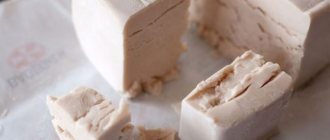Brie is one of the most famous French cheeses around the world. In its homeland, it is considered a delicacy, and in those places where the original recipe has been preserved, the price tag for this cheese is impressive. But you can buy it in almost any grocery store at an affordable price. The product is widely available, so everyone should know how to store brie cheese.
How is royal cheese made?
As already mentioned, the base for brie is cow's milk. The original recipe uses whole meat, although in some countries analogues of the delicacy are made from pasteurized meat. To produce one head of product (with a classic diameter of 35 cm), you need 20 liters of milk heated to 37 degrees. Rennet is added to it. After rolling, the lumps of cheese mass are traditionally transferred to marble molds. At this stage, the French use a special perforated scoop (in France they call it a brie scoop). After 18 hours, the cheese is removed from the mold, well salted and treated with a special fungus, Penicillium candidum. The fungus first creates a characteristic mold crust on the product, and then “invades” the pulp, making it more tender. The ripening process of the delicacy takes from one to two months.
Gastronomic characteristics
This type of cheese is made in the form of disks, the diameter of which is 30-50 cm and the thickness of 3-5 cm. Some manufacturers make the heads taller, but the thicker the brie ring, the worse it ripens. Large heads are most often overripe at the edges and unripe inside. The fact that the cheese is not yet ripe is indicated by the snow-white pulp of the product.
The taste of the delicacy is delicate and pleasant, although with a faint smell of ammonia. The moldy crust has a sharper smell, but it is almost tasteless. Gourmets love brie for its rich aroma. The mature product reveals mushroom and nutty notes that are almost impossible to find in young cheeses. By the way, the younger the brie, the more delicate its taste and aroma. Mature and thin heads usually taste spicy.
Nutritional characteristics and beneficial properties
A slice of French cheese provides the body with a large supply of energy. 100 g of product contains more than 330 kcal, which is almost 16% of the daily requirement. But due to such a high energy value, the product should be consumed in small portions. The calorie content of brie is affected not so much by carbohydrates (there are only 0.5 g of them in 100 g) as by fats.
Interestingly, this type of cheese contains minimal amounts of lactose, although it belongs to the group of dairy products. Due to this, in small quantities it is suitable for people prone to food reactions to lactose. By consuming brie, a person provides himself with several vitamins at once, including from group B, A and D, which have a beneficial effect on metabolic processes in the body, the immune system, the health of bones, teeth, the condition of connective tissue, skin and hair.
Thanks to this set of vitamins, the product is beneficial for vision, the nervous system, prevents insomnia and eliminates chronic fatigue. Brie is also a source of important minerals. Each slice of cheese is not only an amazing taste, but also reserves of calcium, magnesium, phosphorus, which are essential for bone tissue. Brie contains zinc necessary for enzymatic activity, the antioxidant substance selenium, as well as good reserves of copper and manganese.
Like other dairy products, brie contains a lot of protein, which is necessary for all cells of the body for proper formation and growth. But at the same time, the delicacy also has its own unique advantages that cheese mold gives it. The beneficial bacteria living in it are very beneficial for the digestive system.
The special chemical composition of cheese mold also has a beneficial effect on the skin. In particular, this substance promotes the production of melanin, which is not only responsible for skin color, but is also an important factor in protecting against cancer. Eating brie regularly will also help protect against UV rays and prevent sunburn.
How to choose brie cheese
The ideal bar size for uniform ripening is from 30-60cm in diameter and from 3 to 5cm in height. The thinner the head, the sharper the taste. The mold color of a quality cheese should be snow-white (brown-red veins are acceptable), and the flesh should be yellowish.
To determine the quality of a product, you need to press on it before purchasing. If the cheese does not return to its original shape, it is of poor quality. You can determine this by appearance and smell: the crust should not be darkened, and the cheese should not emit a strong ammonia smell.
You cannot store sliced brie cheese on the counter for a long time, namely no more than one day.
Recommendations
If you follow these simple recommendations for storing soft mold cheese, the product will not only retain its unique taste throughout its shelf life, but will also not lose its beneficial properties.
When organizing the storage of soft blue cheese, you need to pay close attention to the original packaging. Most often, manufacturers use thin parchment or foil for their products, which is useful if you have pieces of uneaten cheese left. Although, we all understand that this can never happen with real, tasty cheese with white mold, such as cheese from White Cheese from Zhukovka!
How to store brie cheese
Untouched brie cheese has a shelf life of about 85 days. After this time the quality becomes quite questionable. Once opened, cut cheese cannot be stored for more than 3 days. Once the expiration date has passed, the only thing left to do is throw away the product.
It is not recommended to store brie cheese at room temperature outside the refrigerator, as it will quickly spoil. Keep it in the refrigerator for no more than 3 days and wrap it in parchment paper.
You can also keep it in the freezer to increase its shelf life several times. In this way, the cheese is stored for about three months. But after defrosting, it will lose its original consistency and will only be suitable as an ingredient in some dish.
A product that has recently expired can still be eaten, but only if there are no obvious signs of spoilage. Immunocompromised groups, as well as pregnant women and children should not consume expired brie.
Rules of use
Before serving, this product should be kept for 20 - 30 minutes at room temperature to allow its pulp to melt slightly. Then its taste and aroma qualities can be fully revealed.
Cheese can be consumed in different ways. The still solid product should be cut into triangular slices and consumed as a stand-alone snack or as part of other dishes. And if the pulp has already melted, it is removed from the crust with a spoon.
The moldy crust is the main highlight of brie cheese. Many experts on this issue think so. Therefore, it should also be eaten, just like the pulp. Fears that mold can cause poisoning are completely unfounded. This fungus was bred specifically for this delicious product and cannot cause harm to health.
This delicacy is combined with a large number of products and is used by the French not only as a snack, but also as part of sauces and other dishes.
Nowadays, almost everyone can afford a royal dinner with brie cheese and good wine. If you consume these products in reasonable quantities, they will only bring health benefits. If you were unable to consume the entire head at one time, now you know exactly how to store brie cheese, and you will do it correctly.
Storage Features
In order for the cheese to retain its beneficial and tasteful qualities for as long as possible, manufacturers recommend that they pay special attention to its storage. Basic rules for storing white mold cheese at home:
- soft varieties can be stored at a temperature of 0/+10 ° C for a week;
- at negative temperatures (in the freezer), cheese can be stored for up to one month, but it is worth remembering that freezing leads to a violation of consistency and taste;
- at temperatures below 0°C, the structure becomes grainy, the cheese becomes brittle, and the taste will be sharp;
- during storage, it is necessary to carefully pack the remaining pieces of cheese to protect them from absorbing foreign odors, and other products from the specific smell of white mold;
- You cannot leave soft cheese with mold open, as after a couple of days the product will weather (this applies to any cheese);
- Do not be afraid of changes in the taste of cheese, because thanks to the ripening processes, the taste becomes richer and more vibrant.
It is better to store soft cheeses, such as Brie, Bresse Blue, Camembert and others, at a temperature of +1 / +6 °C. To do this, you can use the manufacturer's packaging; if it is not available, wax paper or foil. Modern manufacturers take this fact into account, and product packaging most often complies with this recommendation. If these requirements are met, the cheese can be safely kept in the refrigerator for one to two weeks with full preservation of taste and aroma.
It is worth knowing that in order to preserve the pleasant, soft taste of blue cheese, you need to take into account the specific type and characteristics of the product. Thus, for some cheeses with white mold and a thin, aromatic crust, preliminary ripening is necessary. For example, Brie can be left at medium temperature for a month. At the same time, the characteristics of the product will become better, the cheese will ripen and acquire a characteristic pronounced aroma.
It is not recommended to keep soft cheeses in the freezer, although it is acceptable. This is especially true for dry freezing - the structure of the product will be changed and graininess will appear. The optimal solution would be “zero cameras”.
The harm of brie cheese
Brie cheese itself does not cause any particular harm, but there are a number of contraindications under which it should not be eaten:
- Allergy to milk protein
- Salt sensitivity
- Pregnancy
In some other cases, it is also not recommended to use the product, but in small doses it does not cause harm. This applies to people with lactose intolerance.











